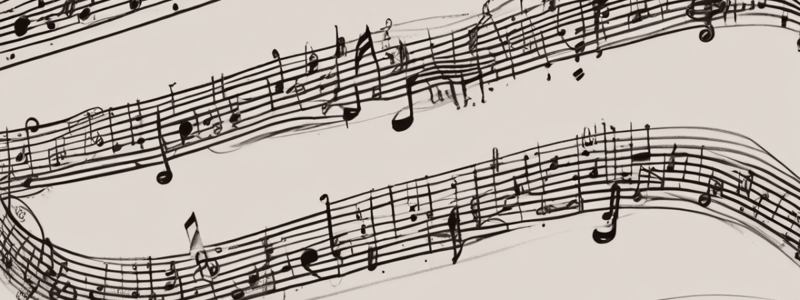Podcast
Questions and Answers
What is a scale in music theory?
What is a scale in music theory?
- A sequence of musical notes ordered by duration
- A sequence of musical notes ordered by pitch (correct)
- A pattern of rhythms in a musical composition
- A type of musical instrument
What is the function of the tonic in a scale?
What is the function of the tonic in a scale?
- To provide a sense of tension
- To create dissonance
- To add complexity to a musical composition
- To establish the key and provide a sense of stability and resolution (correct)
What determines the specific pattern and character of a scale?
What determines the specific pattern and character of a scale?
- Modes
- Scale degrees
- Intervals (correct)
- Key signatures
What is a mode in music theory?
What is a mode in music theory?
What is the pattern of whole steps (W) and half steps (H) in a major scale?
What is the pattern of whole steps (W) and half steps (H) in a major scale?
What is the primary function of a key signature?
What is the primary function of a key signature?
What is the term for the individual notes within a scale?
What is the term for the individual notes within a scale?
What is the first degree in a major scale?
What is the first degree in a major scale?
What is the purpose of sharps (#) and flats () in music notation?
What is the purpose of sharps (#) and flats () in music notation?
What is the relationship between scales and chords in music?
What is the relationship between scales and chords in music?
What is the function of the tonic note in a major scale?
What is the function of the tonic note in a major scale?
What is the interval pattern of the major scale?
What is the interval pattern of the major scale?
What is the function of the subdominant in a major scale?
What is the function of the subdominant in a major scale?
What is the leading tone in a major scale?
What is the leading tone in a major scale?
What is the purpose of understanding scales in music theory?
What is the purpose of understanding scales in music theory?
What is the function of the mediant in a major scale?
What is the function of the mediant in a major scale?
What is the function of the dominant in a major scale?
What is the function of the dominant in a major scale?
Why are scales important in music theory?
Why are scales important in music theory?
What is the primary function of understanding the degrees of the major scale?
What is the primary function of understanding the degrees of the major scale?
What is the number of notes in the major scale?
What is the number of notes in the major scale?
What is the function of the tonic in the minor scale?
What is the function of the tonic in the minor scale?
What is the pattern of whole steps and half steps in the natural minor scale?
What is the pattern of whole steps and half steps in the natural minor scale?
What is the function of the leading tone in the minor scale?
What is the function of the leading tone in the minor scale?
What is the importance of understanding minor scales and degrees?
What is the importance of understanding minor scales and degrees?
What is the degree of the note C in the A natural minor scale?
What is the degree of the note C in the A natural minor scale?
What is the role of the degrees in the minor scale?
What is the role of the degrees in the minor scale?
What is the characteristic of the minor scale?
What is the characteristic of the minor scale?
What is the importance of understanding the degrees of the major scale and minor scale?
What is the importance of understanding the degrees of the major scale and minor scale?
What emotion can the harmonic minor scale convey in melodies?
What emotion can the harmonic minor scale convey in melodies?
What is the function of the raised seventh degree in the harmonic minor scale?
What is the function of the raised seventh degree in the harmonic minor scale?
What is the result of mixing natural minor, harmonic minor, and melodic minor scales together?
What is the result of mixing natural minor, harmonic minor, and melodic minor scales together?
In the key of A harmonic minor, what is the dominant chord?
In the key of A harmonic minor, what is the dominant chord?
What is the benefit of using the melodic minor scale in musical compositions?
What is the benefit of using the melodic minor scale in musical compositions?
Why is it important to pay attention to the chord progression when using the harmonic and melodic minor scales?
Why is it important to pay attention to the chord progression when using the harmonic and melodic minor scales?
What is the result of raising the seventh degree by a half step in the natural minor scale?
What is the result of raising the seventh degree by a half step in the natural minor scale?
What is the characteristic of the harmonic minor scale?
What is the characteristic of the harmonic minor scale?
What happens to the melodic minor scale when moving downwards?
What happens to the melodic minor scale when moving downwards?
What is the emotional quality commonly associated with the harmonic minor scale?
What is the emotional quality commonly associated with the harmonic minor scale?
In which type of music is the melodic minor scale commonly used?
In which type of music is the melodic minor scale commonly used?
What is the purpose of the harmonic minor scale in music?
What is the purpose of the harmonic minor scale in music?
What is the difference between the harmonic and melodic minor scales?
What is the difference between the harmonic and melodic minor scales?
What is the use of the harmonic minor scale in music?
What is the use of the harmonic minor scale in music?
What is the result of understanding the harmonic and melodic minor scales?
What is the result of understanding the harmonic and melodic minor scales?
Why is the melodic minor scale used in jazz and fusion music?
Why is the melodic minor scale used in jazz and fusion music?
Flashcards are hidden until you start studying
Study Notes
Understanding Scales: Definition and Components
- A scale is a sequence of musical notes ordered by pitch, spanning an octave and following a specific pattern of intervals between successive notes.
- Scales are used to create melodies, chords, and harmonies, and form the backbone of musical compositions.
Components of Scales
- Tonic: The first note of a scale, establishing the key and providing a sense of stability and resolution.
- Intervals: The distances in pitch between two consecutive notes of a scale, determining the specific pattern and character of the scale.
- Scale Degrees: Individual notes within a scale, assigned numbers to identify their position within the scale.
- Modes: Derived from scales, representing different starting points within the same set of notes, with unique tonal characteristics.
- Key Signatures: Simplifying the notation of scales, indicating the pitches used within a particular scale or mode.
- Scales and Chords: Closely related, with harmonies and chords constructed by stacking specific intervals on top of each other.
The Major Scale and Degrees
- The major scale is a diatonic scale consisting of seven notes, arranged according to a specific pattern of intervals.
- Degrees of the Major Scale:
- Tonic (Root): The starting note of the major scale, establishing the key.
- Supertonic: The second degree, a whole step above the tonic.
- Mediant: The third degree, a whole step above the supertonic.
- Subdominant: The fourth degree, a half step above the mediant.
- Dominant: The fifth degree, a whole step above the subdominant.
- Submediant: The sixth degree, a whole step above the dominant.
- Leading Tone: The seventh degree, a half step below the tonic, creating tension and leading to the tonic.
The Minor Scale and Degrees
- The natural minor scale, also known as the Aeolian mode, follows a specific pattern of whole steps and half steps.
- Degrees of the Minor Scale:
- Tonic (First Degree): The starting note of the minor scale, serving as its foundation.
- Supertonic (Second Degree): A whole step above the tonic.
- Mediant (Third Degree): A whole step above the supertonic.
- Subdominant (Fourth Degree): A whole step above the mediant.
- Dominant (Fifth Degree): A whole step above the subdominant.
- Submediant (Sixth Degree): A whole step above the dominant.
- Leading Tone (Seventh Degree): A half step above the subdominant, creating tension and leading to the tonic.
Harmonic and Melodic Minor Scales
- Harmonic Minor Scale: Constructed by raising the seventh degree of the natural minor scale, introducing a leading tone.
- Melodic Minor Scale: Has a raised sixth and seventh degree when ascending, and reverts to the natural minor scale when descending.
- Properties of Harmonic Minor Scale: Has a unique interval pattern, often associated with Middle Eastern, Spanish, and classical music.
- Properties of Melodic Minor Scale: Has a flexible and expressive quality, commonly used in jazz, fusion, and contemporary music.
Practical Applications
- Harmonic and melodic minor scales can be used in various contexts such as composing melodies, building chord progressions, creating solos, and improvising.
- By exploring and experimenting with these scales, you can enhance your musical compositions, chord progressions, solos, and improvisations.
Studying That Suits You
Use AI to generate personalized quizzes and flashcards to suit your learning preferences.




